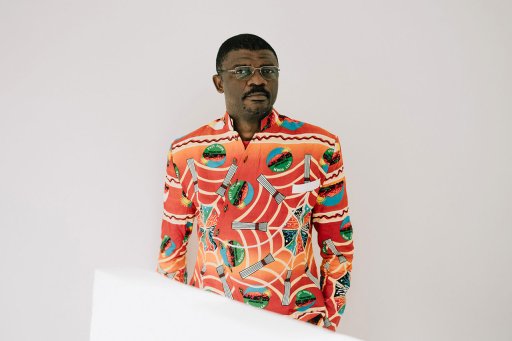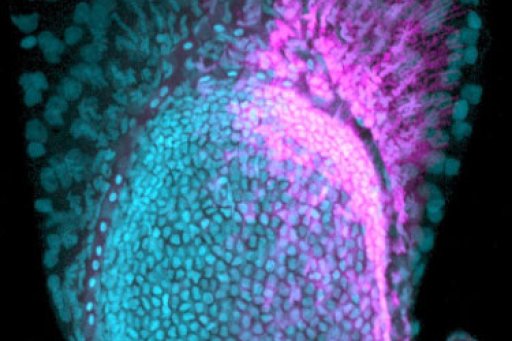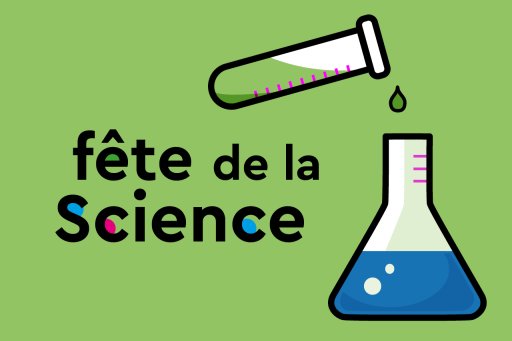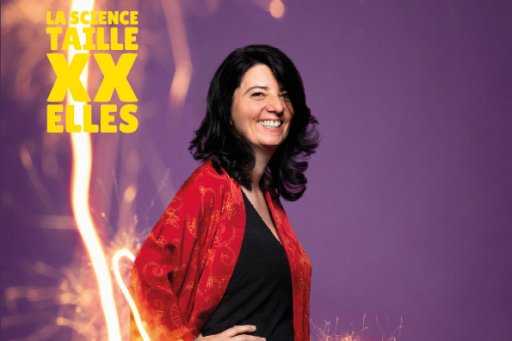![[alt_0a44aa7b-1cb6-4a9e-93db-8324a6afadfd]](/media/chercheurs/UPL4303121985700913872_portait_Pauline_Besserve.jpg)
Have you always been fascinated by physics ?
Initially, I was more of a literary student, preferring languages, French... In the second year of high school, I had an incredible physics teacher, who was a great teacher, and turned my vision of this discipline on its head. I realized that beyond the practical side, science implied a whole context of understanding the world and the interactions between people to build this collective knowledge. My tenth grade teacher was from the ENS in Lyon, a school that trains students to become teacher-researchers. After the baccalauréat, I enrolled in a preparatory class in physics and chemistry, not knowing much about the course, but keeping in mind that I wanted to go to the ENS in Lyon... which I managed to do at the end of the preparatory class. This school is not naturally oriented towards industry, and I myself was rather tempted by an academic career. Curiosity prompted me to embark on a double degree with the École Centrale de Lyon, an engineering school, in parallel with my master's degree in physics. As part of this, I had the opportunity to do my first internship in a start-up company, which I really enjoyed, and afterwards I kept one foot in industry.
You study the physics that emerges from the behavior of electrons in certain materials..
Matter is made up of atoms, and in an atom there's the nucleus, made up of protons and neutrons, around which " gravitate " the electrons. What we need to imagine is that, in a solid, nuclei are static and only electrons move through the structured network of atoms, forming the electric current.
The collective behavior of these electrons gives rise to various " electronic phases ", depending on numerous parameters such as the spatial arrangement of the atoms or the temperature... These include the superconducting phase: a phase in which, among other things, electrical conduction is resistance-free and therefore loss-free.
Conventional superconducting materials are superconducting at very low temperatures, around absolute zero, i.e. -273.15 °C. At these temperatures, technological applications are impossible : it's hard to imagine superconducting cables being maintained at this refrigeration level in a nuclear power plant at home !
It has been discovered that superconductivity can be achieved at much higher temperatures in certain materials known as " correlated ". How can we characterize them ?
Correlated materials are solids or liquids in which electrons interact strongly : they " see ". Some metal oxides, for example, fall into this category. The origin of superconductivity in correlated materials is not yet well understood, yet it is of major industrial interest.
To describe the behavior of a set of particles, physicists often use "one-body" theories ( ). These postulate that the influence felt by a particle, and attributable to the other particles surrounding it, can be represented as an average influence, as if the particle were moving in molasses. Here, a particle corresponds to an electron.
In some cases, such as with correlated materials, these one-body theories lead to aberrant results: we fail to describe the physics we observe. Indeed, when we study a large ensemble of electrons in these materials, we notice unusual phenomena that are totally different from the behavior of an individual electron.
It is therefore necessary to create specific tools to tackle this physics " with N quantum bodies ", where N refers to a large number of particles. The N-body problem is notoriously difficult in physics, and also arises in astronomy.
Your research involves developing new tools for studying correlated materials..
I do numerical physics : I develop and implement numerical algorithms with the aim of solving physical problems. But before doing so, you need to have established approximate models that prescribe the equations to be solved: by hand when possible, but very often with the help of a computer.
In the years 1990, a theory was co-developed by Antoine Georges, a professor at the Collège de France. Called Dynamic Mean Field Theory (DMFT), it focuses on a small number of atoms in the material to describe the arrangement of electrons, which is then extrapolated to the material as a whole. The greater the number of atoms taken into account, the greater the ability to capture large-scale physical phenomena, and the better the approximation of the model.
Several algorithms have been generated in classical computer science to solve the DMFT equations. However, they all face the same limit : the memory and computation time they require increase exponentially with the number of atoms considered. For example, to go from one atom to two, you need to quadruple the resources : that's very fast, and it severely limits the use of conventional computers.
In contrast, the quantum computer, which relies on the phenomena of quantum mechanics for calculation, could circumvent this limitation.
![[alt_3c124a1e-f59c-4b39-8a21-e1b1b15cd2f0]](/media/chercheurs/UPL8984178932809024236_photo_Pauline_Besserve.jpg)
What phenomena is this computer based on ?
First of all, in quantum mechanics, a particle is not in a precise location : it is " delocalized ", with certain probabilities of being in one place or another at a given moment. In a quantum computer, the same principle applies : the basic unit of computation, the " qubit " - quantum bit - can be in any state, a superimposed mixture of 0 and 1, as opposed to the classical bit, which can only be either 0 or 1. A qubit can be in a superposed state... just as the computer's total register of qubits will also be superposed, by virtue of a second key principle called " entanglement ". According to this principle, it is sometimes impossible to assign a state to each qubit individually, and only the entire register can be assigned. The number of bit strings that can be present in the mix thus increases exponentially with the number of qubits : an extremely powerful process. The quantum computer would be capable of processing much more information at once.
Do we currently have a real quantum computer ?
No. Making and manipulating qubits represents a colossal engineering challenge. Only a few small prototypes, with a few dozen qubits and very prone to errors, exist.
The aim of my thesis is to study the contribution of computation carried out on these mini-quantum computers and to see whether, despite their imperfections, they could not be used to model the physics of correlated materials. The idea is to design novel hybrid algorithms, combining quantum and classical computation. The quantum computer does not supplant the classical computer, but assists it with the most difficult part of the calculation.
What convinced you to do a PhD in quantum computing ?
Two things came together at : on the one hand, at the ENS in Lyon, I felt a great interest in the quantum mechanics lecture, a discipline that exposes completely atypical concepts. Secondly, I attended a lecture dedicated specifically to quantum computing, which brought together physics, mathematics and computer science students in the same lecture hall. That's when I really realized that I could do research in this fast-growing field.
I had spotted that the French digital services company Atos was developing activities around quantum computing. I applied directly to them for my end-of-studies internship, which led to a Cifre thesis. This is a tripartite thesis between a laboratory, a company and a doctoral student, subsidized by the French National Association for Research and Technology (ANRT). The idea is to decompartmentalize and create synergies between business and academia : on a day-to-day basis, I divide my working time between these two players.
How do you work on a daily basis ?
I work exclusively on the computer and code in Python. There are very few quantum computer prototypes available. So before testing them, I simulate them using a very powerful classical computer, the Quantum Learning Machine , accompanied by a specific computer code library developed by Atos, which mimics the behavior of a quantum computer.
I alternate between the main Collège de France site, in the team of my thesis co-supervisor Michel Ferrero, and the Atos site, with my co-supervisor Thomas Ayral. The advantage of being at the Collège de France is that I can easily attend lectures given by Professor Antoine Georges. For my research, however, I need to understand the framework of my thesis and the physical theories behind digital applications.
How does your research motivate you ?
I find it particularly exciting to see quantum computing, a science still in its infancy, emerging before our very eyes. There's a lot of trial and error involved, and we feel that there are still many things to discover, including major technological breakthroughs.
I'm happy to have reached this point, but what could have stopped me was self-censorship. Not daring, not feeling capable of succeeding. I thought about missing the ENS oral exam for these reasons ! Today, I'm much less inclined to do that, even though I still doubt myself from time to time.
Fortunately, I'm lucky enough to be supported by a great team. There are many different ways of supervising a thesis student, and my supervisors have an approach that I think is very healthy, that of encouraging me to ask myself the right questions to break down and methodically solve the problems I encounter. It's within their remit, of course, but I'm grateful to them for it.
---------
Pauline Besserve works at the Physics Institute of the Collège de France, in the Quantum Condensed Matter Physics chair held by Prof. Antoine Georges. Her PhD is supervised by Thomas Ayral (Atos) and Michel Ferrero (Centre de physique théorique) under the Cifre program. His thesis is entitled " Algorithmes hybrides quantiques-classiques pour le problème à N corps quantique ".
Photos © Patrick Imbert
Interview by Océane Alouda







